👋🌵 Welcome to the ultimate guide on 🏡 indoor succulents! These water-wise plants are perfect for adding a splash of greenery inside.
Looking for easy-care green friends? Succulents are the go-to! With their diverse hues, shapes, and textures, they effortlessly spruce up any area. Great for both novice and expert plant parents. Check out the Haworthia Truncata, with its cool, translucent-tipped, triangular leaves 🍃. Or, the Pilea Peperomioides, with its playful, round, coin-like leaves that can bring a whimsical touch to your space 💚.
Christmas Cactus (Schlumbergera x Buckleyi)
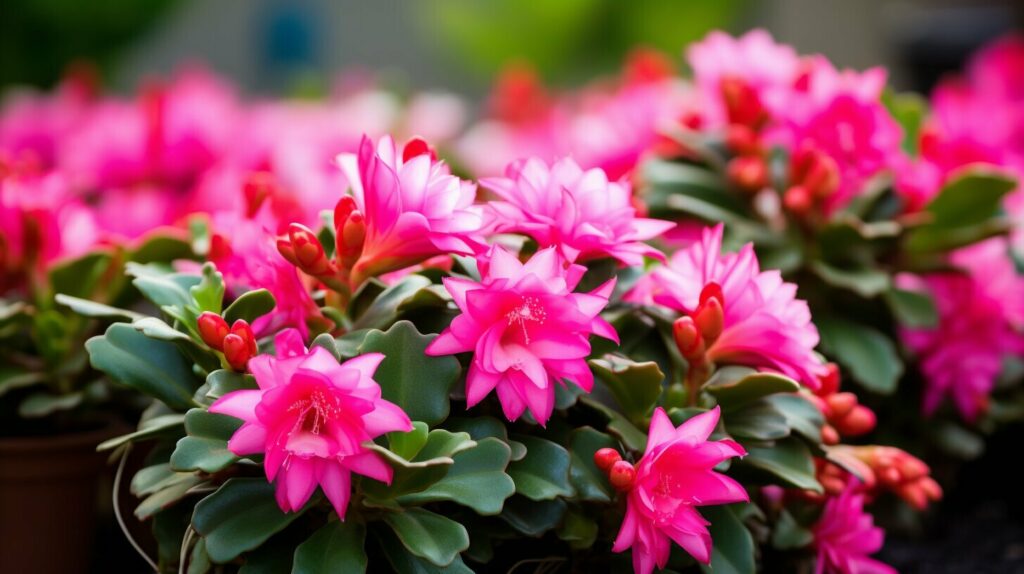
The Christmas cactus, scientifically known as Schlumbergera x Buckleyi, is a beautiful succulent that adds a touch of festive cheer to any indoor garden. This succulent is popular for its flat, fleshy stems and vibrant pink blooms that resemble delicate holiday ornaments. It is a favorite among plant enthusiasts, especially during the holiday season when it bursts into bloom.
To care for your Christmas cactus, place it in a location with bright, indirect light, such as near a window or under a grow light. Avoid placing it in direct sunlight, as this can cause sunburn to its leaves. The Christmas cactus prefers temperatures between 65°F and 75°F (18°C to 24°C), making it ideal for indoor environments.
Hens-and-Chicks (Echeveria Elegans and Sempervivum Tectorum)
If you’re looking for unique and visually interesting succulents to add to your indoor garden, consider hens-and-chicks. These succulents, also known as Echeveria Elegans and Sempervivum Tectorum, are characterized by their ability to produce small, identical “chicks” around the mother plant. Their distinctive rosette shapes and various colors make them eye-catching additions to any space.
Hens-and-chicks succulents are relatively easy to care for, making them suitable for beginners. They thrive in bright light, so placing them near a window or under grow lights is ideal. It’s important to avoid direct sunlight, as it can cause their leaves to burn. As for watering, hens-and-chicks should be watered when the soil is slightly dry. Overwatering can lead to root rot, so it’s crucial to allow the soil to dry out between waterings.
Jade Plant (Crassula Ovata)
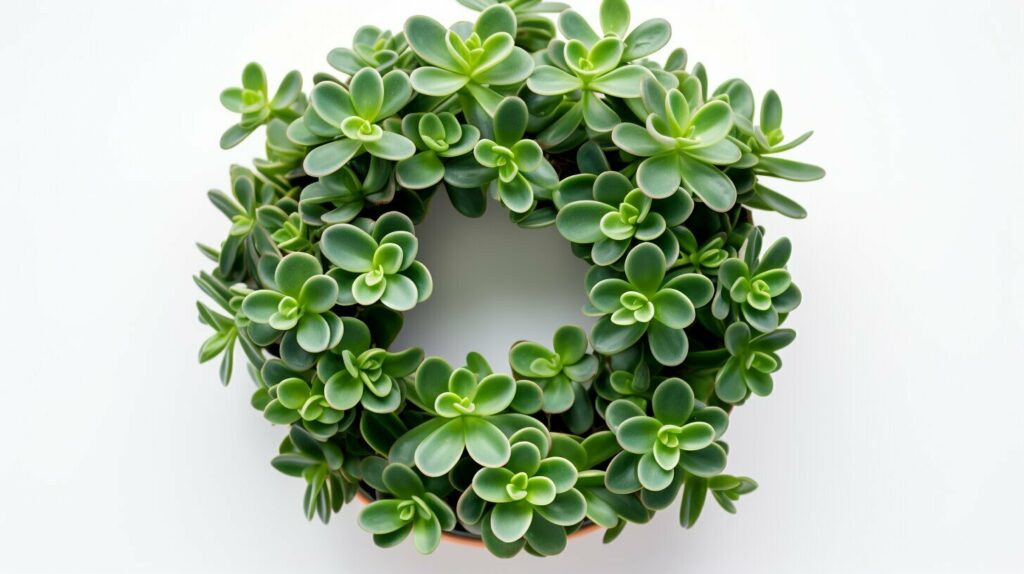
One of my favorite succulents to grow indoors is the Jade Plant, also known as Crassula Ovata. With its thick, glossy green leaves and unique tree-like appearance, the Jade Plant adds a touch of elegance to any indoor space. It’s not just a beautiful plant, but also one that is easy to care for, making it a perfect choice for beginner gardeners.
To ensure the health and well-being of your Jade Plant, it’s important to provide it with the right growing conditions. This succulent thrives in bright light, so place it near a window where it can get plenty of indirect sunlight. However, be careful not to expose it to direct sunlight for extended periods, as it can scorch the leaves.
Care Tips for Jade Plant:
- Place in bright, indirect sunlight
- Allow the soil to dry out completely between waterings
- Use a well-draining potting mix
- Avoid overwatering and standing water in the saucer
- Feed with a balanced, water-soluble fertilizer during the growing season
Aloe Vera
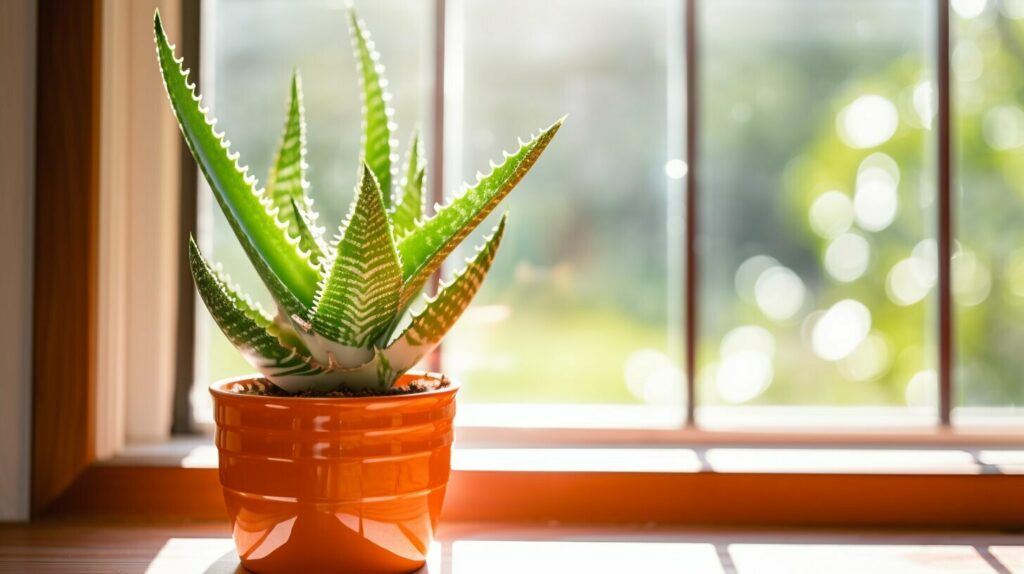
Aloe vera is a versatile succulent that not only adds beauty to your indoor garden but also offers numerous health benefits. This plant, with its long, slender leaves and gel-filled interior, has been used for centuries for its medicinal properties. Here are some essential care tips and medicinal uses of aloe vera to help you make the most of this remarkable plant.
To keep your aloe vera plant thriving, it’s important to provide it with the right conditions. Aloe vera prefers bright light, so place it near a sunny window where it can receive ample sunlight. However, be cautious of intense, direct sunlight, as it can scorch the leaves. In terms of watering, aloe vera is drought-tolerant and can withstand periods of dry soil. Water the plant deeply but infrequently, allowing the soil to dry out completely between waterings. Overwatering can lead to root rot, so it’s best to err on the side of underwatering.
Snake Plant (Sansevieria Trifasciata)
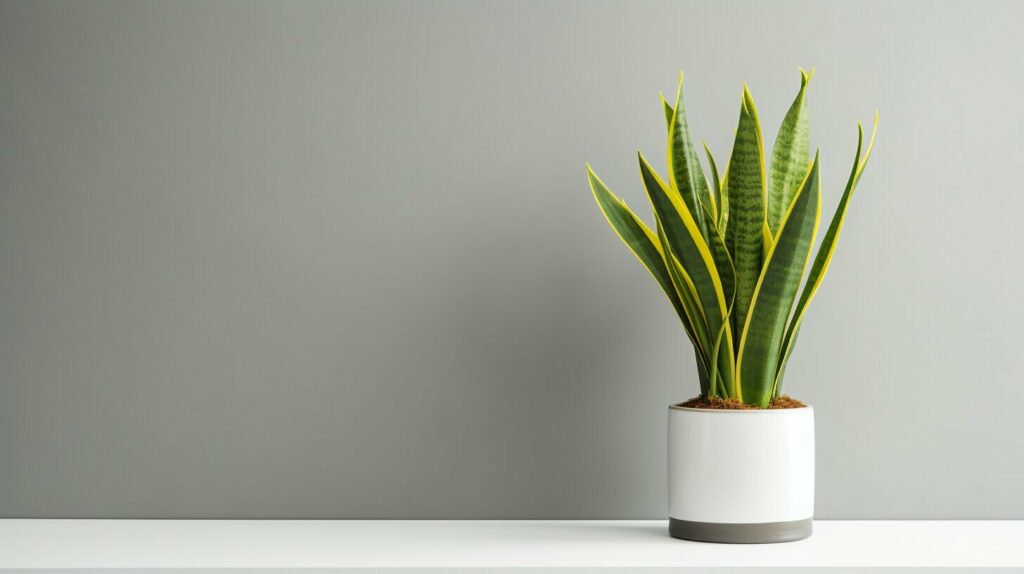
Welcome to the snake plant section! If you’re looking for a low-maintenance succulent that can thrive in a variety of lighting conditions, then the snake plant (Sansevieria Trifasciata) is the perfect choice for you. Also known as the mother-in-law’s tongue, this succulent is characterized by its tall, upright leaves that grow straight up and can reach several feet in height.
One of the reasons why snake plants are so popular is their ability to tolerate low-light conditions, making them perfect for offices and indoor spaces with limited sunlight. In fact, they can survive in artificial light alone, so you don’t have to worry about finding the perfect spot near a window. And if you’re someone who tends to forget about watering your plants, the snake plant is for you. They have a high drought tolerance and can go for extended periods without water, making them ideal for busy individuals or those who may not have a green thumb.
Benefits of Snake Plants:
- Low-maintenance and drought-tolerant
- Tolerates low-light conditions
- Efficient air purifier
- Can grow in a variety of spaces
Panda Plant (Kalanchoe Tomentosa)
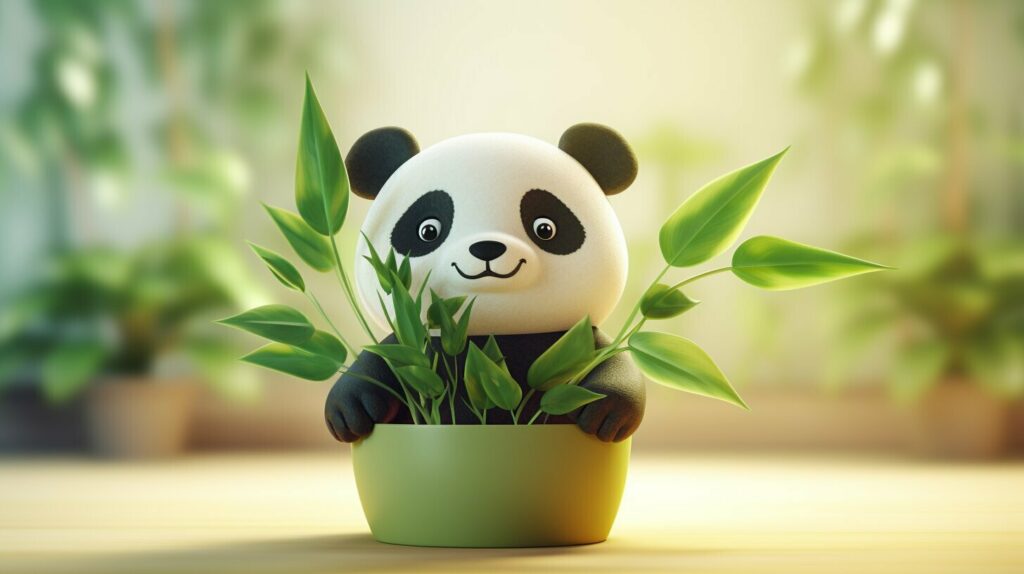
The Panda Plant, also known as Kalanchoe Tomentosa, is a charming succulent that showcases its unique appearance with fuzzy, gray-green leaves covered in soft silver hairs. This distinct feature gives the plant a delightful and cuddly panda-like appearance, hence its name. The Panda Plant can add a touch of whimsy and visual interest to any indoor garden or space.
One of the reasons why the Panda Plant has gained popularity among succulent enthusiasts is its easy care requirements. This low-maintenance succulent thrives in bright, indirect light, making it perfect for placing near a sunny window or under a grow light. However, it’s important to avoid exposing the Panda Plant to direct sunlight, as it can cause leaf burn.
Ponytail Palm (Beaucarnea Recurvata)

The ponytail palm, also known as Beaucarnea Recurvata, is a unique and striking succulent that can bring a touch of exotic beauty to your indoor garden. Despite its name, the ponytail palm is not a palm tree but belongs to the agave family. It features a long, slender trunk topped with a dense cluster of long, curly leaves, resembling a ponytail. This distinctive appearance makes it a visually appealing choice for any plant enthusiast.
The care for the ponytail palm is relatively easy, making it perfect for both experienced gardeners and beginners. It thrives in bright light, so placing it near a sunny window is ideal. However, it can also tolerate lower light conditions, although its growth may be slower. As for watering, the ponytail palm is drought-tolerant and prefers to dry out between waterings. Overwatering can lead to root rot, so it’s crucial to let the soil dry out completely before watering it again.
Here are some care tips for your ponytail palm:
- Light: Place your ponytail palm in bright, indirect light. It can tolerate some direct sunlight but may burn if exposed to too much.
- Water: Allow the soil to dry out completely between waterings. Water sparingly during the winter months when its growth slows down.
- Soil: Use a well-draining soil mix specifically formulated for succulents or cacti.
- Temperature: The ponytail palm prefers average to warm temperatures between 65°F and 85°F (18°C – 29°C).
- Fertilizer: Feed your plant with a balanced, water-soluble fertilizer once a month during the growing season (spring and summer).
- Propagation: Propagating the ponytail palm can be challenging. It’s best to purchase a new plant from a reputable nursery.
African Milk Tree (Euphorbia Trigona)

When it comes to unique and visually striking succulents, the African Milk Tree (Euphorbia Trigona) is definitely a standout. This succulent features upright branched stems lined with sharp thorns, giving it an edgy charm. Its striking appearance makes it a popular choice for indoor gardening.
To care for an African Milk Tree, it’s important to provide it with bright light. Place it near a sunny window or under grow lights to ensure optimal growth. Additionally, this succulent prefers evenly moist soil, so water it regularly, allowing the soil to dry out slightly between waterings.
Zebra Haworthia (Haworthia Fasciata)
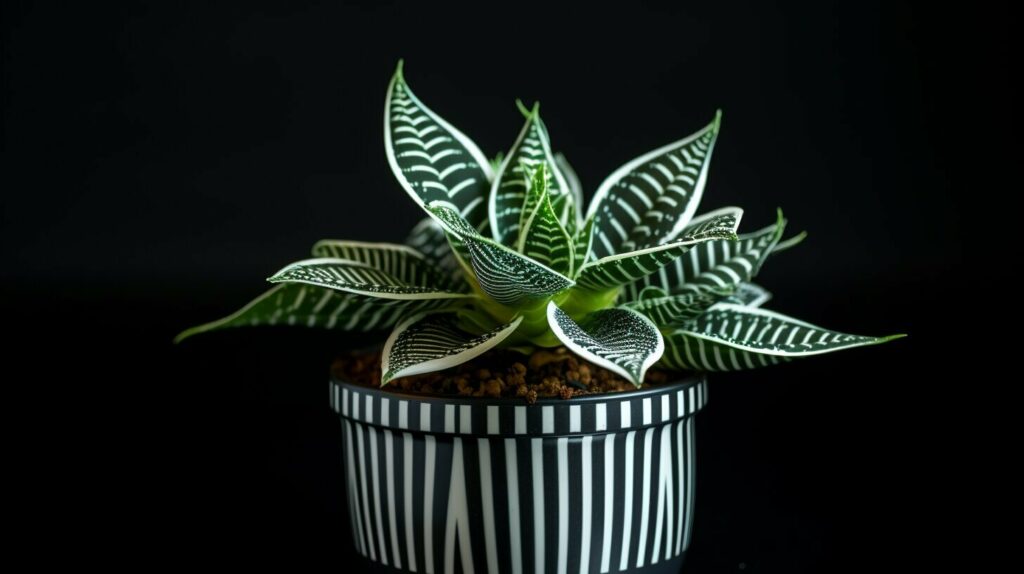
Welcome to the world of Zebra Haworthia, a delightful succulent that will add a touch of elegance to your indoor garden. With its spiky green leaves and distinctive raised white ridges, this small succulent is a charming addition to any space. Its compact size makes it perfect for windowsills or desktop gardens, adding a pop of natural beauty to your daily life.
When it comes to caring for Zebra Haworthia, simplicity is key. This succulent thrives in bright light, so be sure to place it in a location where it can soak up the sun’s rays. As for watering, it’s important to let the soil dry out completely between waterings to prevent root rot. A good rule of thumb is to water your Zebra Haworthia when the soil is dry to the touch.
Variegated Kalanchoe (Kalanchoe Fedtschenkoi “Variegata”)
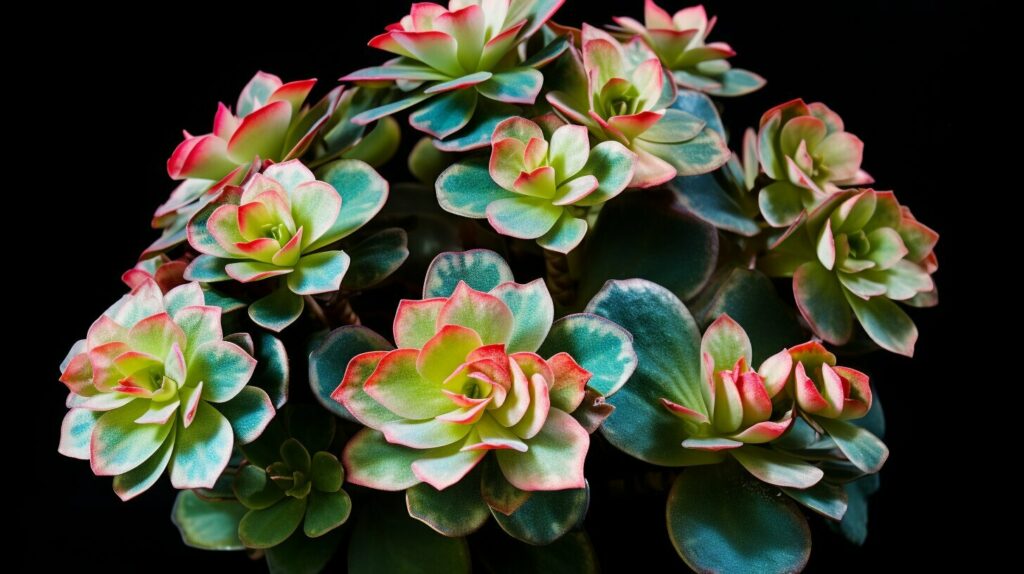
The variegated kalanchoe, also known as Kalanchoe Fedtschenkoi “Variegata,” is a stunning succulent that adds a touch of elegance to any indoor garden. Its scalloped gray-green leaves are edged in delicate white and pink, creating a beautiful contrast. This unique coloration makes it a popular choice among succulent enthusiasts.
In terms of care, the variegated kalanchoe thrives in bright light, so placing it near a window where it can receive ample sunlight is ideal. However, it’s important to avoid direct sunlight during the hottest part of the day, as it can scorch the leaves. The soil should be well-draining to prevent waterlogging, which can lead to root rot.
When it comes to watering the variegated kalanchoe, a cautious approach is best. Allow the soil to dry out between waterings, as overwatering can be detrimental to the plant’s health. Succulents, in general, are adapted to survive in arid conditions, so they have a natural ability to store water in their leaves. Remember, it’s always better to underwater than to overwater.
Aeonium ‘Zwartkop’
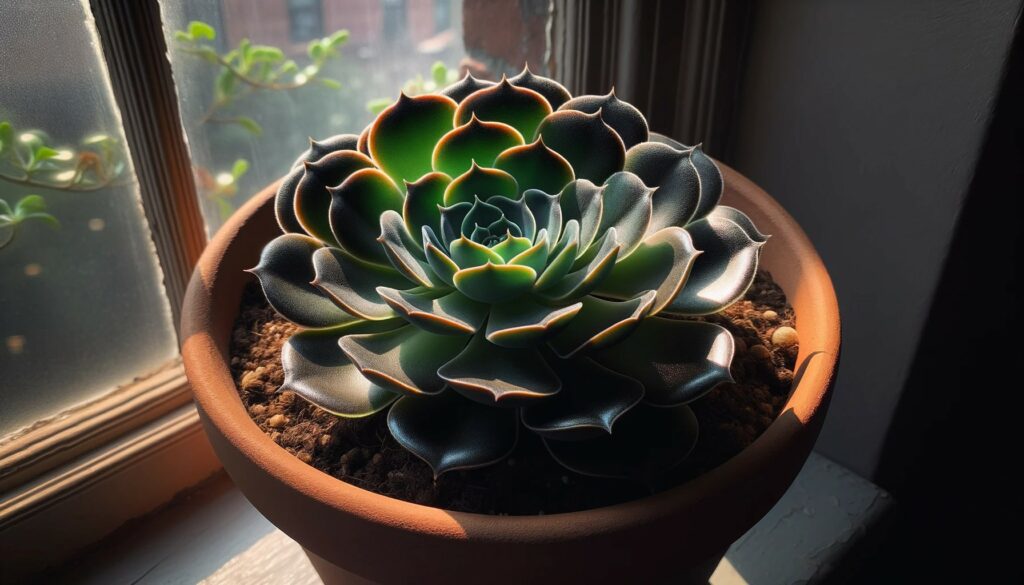
Aeonium ‘Zwartkop’ is a stunning succulent that adds a touch of drama to any indoor garden. Its almost black, rosette-shaped leaves create a striking contrast against its bright green stems. This unique coloration makes Aeonium ‘Zwartkop’ a favorite among succulent enthusiasts.
Caring for Aeonium ‘Zwartkop’ is relatively easy. This succulent thrives in bright light, so it’s important to place it in a location where it can receive plenty of sunlight. However, be cautious of intense, direct sunlight as it can scorch the leaves. Aeonium ‘Zwartkop’ prefers well-draining soil, so make sure to use a potting mix specifically formulated for succulents.
String of Pearls (Senecio Rowleyanus)
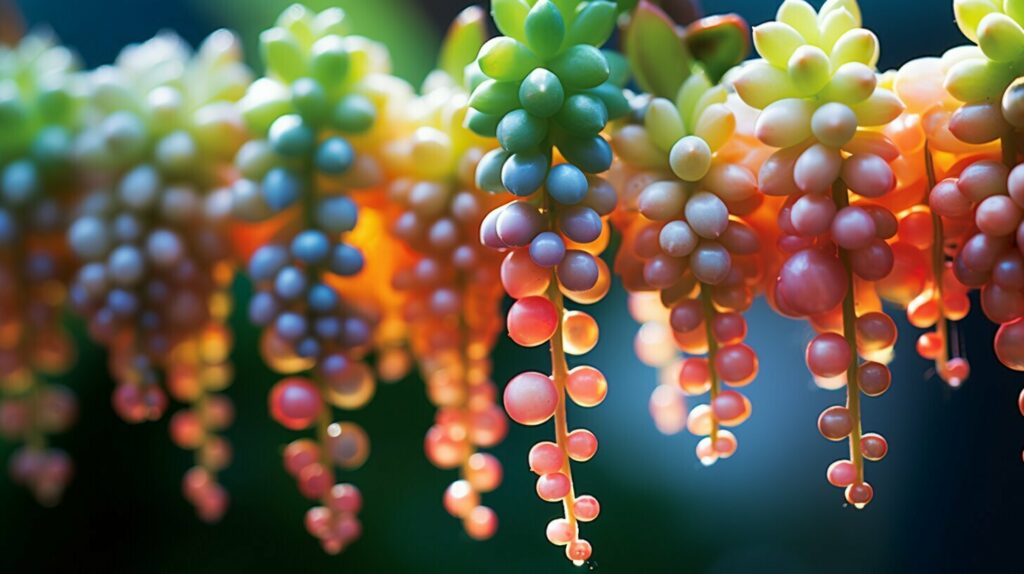
The String of Pearls (Senecio Rowleyanus) is a unique and captivating succulent that is sure to add a touch of elegance to any indoor space. This plant features long, trailing stems adorned with small, bead-like leaves that resemble a string of pearls, hence its name. Its delicate appearance and lush green color make it a popular choice for hanging baskets, terrariums, or as a standalone statement piece.
Caring for the String of Pearls is relatively easy, making it suitable for both experienced and novice gardeners. Here are a few key care tips to ensure the health and longevity of your plant:
- Light: The String of Pearls thrives in bright, indirect light. Place it near a window where it can receive several hours of sunlight each day. However, be cautious of exposing it to intense, direct sunlight as this can lead to sunburn and damage the delicate foliage.
- Watering: It’s important to strike the right balance when watering the String of Pearls. Overwatering can lead to root rot, while underwatering can cause the leaves to shrivel and dry out. Allow the soil to dry out partially between waterings and then thoroughly water the plant, allowing excess water to drain away.
- Soil: The String of Pearls requires well-draining soil to prevent waterlogged roots. A cactus or succulent potting mix is a suitable choice for this plant, as it provides the necessary drainage while retaining some moisture.
- Humidity: This succulent prefers average indoor humidity levels. If your home is particularly dry, you can increase humidity around the plant by placing it on a tray filled with water and pebbles or by using a humidifier.
Haworthia Limifolia
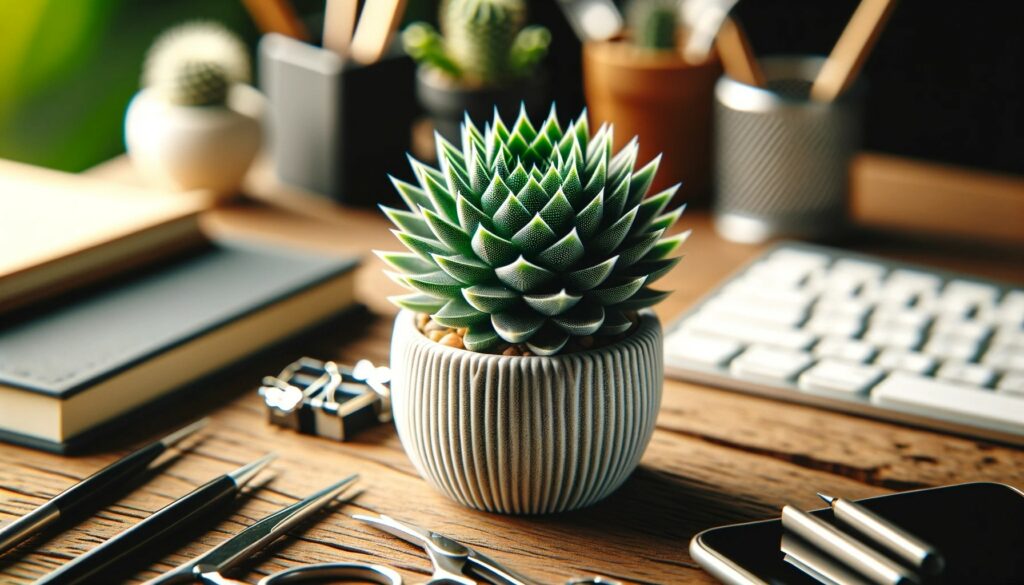
Hello, fellow succulent enthusiasts! Today, I want to introduce you to a delightful succulent known as Haworthia Limifolia. This small succulent features spiky green leaves with raised white ridges, creating a captivating geometric pattern.
Haworthia Limifolia is perfect for those looking to add a touch of unique charm to their windowsills or desktop gardens. Its compact size makes it an ideal choice for smaller spaces, and its striking appearance is sure to catch the eye of anyone who sees it.
FAQ
What are the best succulents for indoor gardening?
Some of the best succulents for indoor gardening are Haworthia Truncata, Pilea Peperomioides, Echeveria Elegans, Sempervivums, Agave Americana, Sedum Dasyphyllum, Crassula ‘Gollum’, Aloe Aristata, Graptopetalum Pentandrum Subsp. Superbum, Sedum Morganianum ‘Burrito’, and more.
How do I grow succulents?
Succulents thrive in bright light and well-drained soil. It’s important to avoid over-watering and water them only when the soil is dry. Choose containers with ample drainage holes and shallow pots. Avoid frequent repotting.
What are some popular succulents for indoor gardening?
Some popular succulents for indoor gardening are the Christmas cactus, Hens-and-Chicks (Echeveria Elegans and Sempervivum Tectorum), jade plant, aloe vera, snake plant, panda plant, ponytail palm, African milk tree, zebra haworthia, variegated kalanchoe, Aeonium ‘Zwartkop’, string of pearls, and Haworthia Limifolia.
How do I care for a Christmas cactus?
The Christmas cactus thrives in bright light and should be watered when the top inch of soil is dry. It is a great addition to your indoor garden, especially during the holiday season when it blooms.
How do I care for Hens-and-Chicks succulents?
Hens-and-Chicks succulents, such as Echeveria Elegans and Sempervivum Tectorum, thrive in bright light. They should be watered when the soil is slightly dry to avoid root rot.
How do I care for a jade plant?
The jade plant should be planted in well-draining soil and allowed to dry out completely between waterings. It is a low-maintenance succulent perfect for beginner gardeners.
How do I care for an aloe vera plant?
Aloe vera prefers bright light and should be watered when the soil is dry. Its gel-filled leaves can be used to soothe sunburns and other skin conditions.
How do I care for a snake plant?
The snake plant can tolerate low-light conditions and should be watered when the soil is dry. It is known for its air-purifying properties.
How do I care for a panda plant?
The panda plant should be placed in bright, indirect light and watered when the soil is slightly dry to prevent root rot.
How do I care for a ponytail palm?
The ponytail palm thrives in bright light and low humidity. It requires minimal watering, making it a low-maintenance choice for indoor gardening.
How do I care for an African milk tree?
The African milk tree requires bright light and evenly moist soil. Its milky sap can irritate the skin, so it should be handled with care.
How do I care for a zebra haworthia?
The zebra haworthia requires bright light and should be watered when the soil is dry.
How do I care for a variegated kalanchoe?
The variegated kalanchoe requires bright light and well-draining soil. It should be watered when the soil is dry.
How do I care for Aeonium ‘Zwartkop’?
Aeonium ‘Zwartkop’ requires bright light and should be watered when the soil is dry. It can produce tall stems with yellow flowers.
How do I care for a string of pearls?
The string of pearls thrives in bright, indirect light and should be watered when the soil is slightly dry. It is a beautiful addition to hanging baskets or succulent terrariums.
How do I care for a Haworthia Limifolia?
Haworthia Limifolia requires bright light and should be watered when the soil is dry. It is well-suited for windowsills or desktop gardens.





